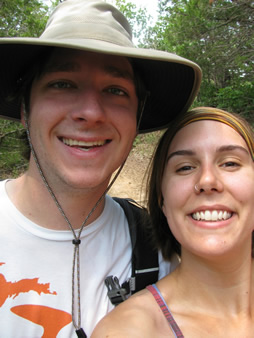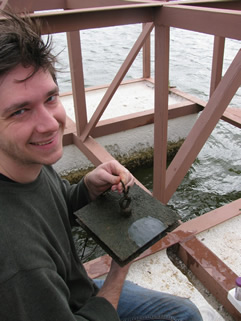FIELD NOTES
2012 Page 8
FRIENDS OF THE UNIVERSITY OF OKLAHOMA BIOLOGICAL STATION
Graduate Students - Thayer Hallidayschult and Jessica Beyer 
By Thayer Hallidayschult
Jessica Beyer and I are PhD students in the Biology Department at the University of Oklahoma. Since moving to Oklahoma in 2010, the OU Biological Station has played a central role in our work. Both Jessica and I are carrying out research inspired by Lake Texoma, but we each work on very different research questions.
I am currently interested in how two invasive species, zebra mussels and Harris mud crabs are affecting the native community and water quality of Lake Texoma, and how they are interacting with each other. Both of these invasive species arrived in Lake Texoma in 2009, but they came from very different places. Zebra mussels are originally from Eastern Europe, and have spread south and west in the United States from the Great Lakes, where they originally invaded in 1986. Harris mud crabs are originally a marine species, native to estuaries in the eastern United States. However, they were introduced to inland waters in Texas in the 1990’s,  and have been migrating northward through Texas since then. Zebra mussels reach very high population densities and rapidly encrust hard surfaces, but we don’t know how they change habitats in ways that affect other species in the lake. In particular, I’m investigating the role zebra mussels play in the ecology of the Harris mud crab, as they may provide both food and shelter for these small invasive crabs. I also study the reproductive patterns of both species, by visiting the Biological Station once a month to collect samples from Lake Texoma. I look for planktonic larvae of both the crabs and zebra mussels using zooplankton net samples, and I use settling plates (see photo) to measure how many zebra mussels are attaching to hard surfaces and how fast they are growing.
and have been migrating northward through Texas since then. Zebra mussels reach very high population densities and rapidly encrust hard surfaces, but we don’t know how they change habitats in ways that affect other species in the lake. In particular, I’m investigating the role zebra mussels play in the ecology of the Harris mud crab, as they may provide both food and shelter for these small invasive crabs. I also study the reproductive patterns of both species, by visiting the Biological Station once a month to collect samples from Lake Texoma. I look for planktonic larvae of both the crabs and zebra mussels using zooplankton net samples, and I use settling plates (see photo) to measure how many zebra mussels are attaching to hard surfaces and how fast they are growing.
Jessica works on understanding how blooms of harmful toxin-producing algae affect herbivorous zooplankton in Lake Texoma. She is planning experiments to measure how algal blooms have changed rotifers (a group of zooplankton) over time, and whether particular populations or species of rotifers have evolved strategies to help them survive during bloom periods. To test these ideas, Jessica spent last summer starting clonal lines of rotifers to use in her experiments. She collected sediment from four sites across Lake Texoma from which she isolated and hatched rotifer resting eggs to create many different lines of rotifers for her experiments. She plans to test in the lab how these clonal rotifer populations respond to toxic algae.
For both of us, the University of Oklahoma Biological Station has provided both funding and laboratory space for pursing our research. Because the station provides housing for graduate students, both Jessica and I have been able to spend our last two summers on Lake Texoma hard at work, without having to worry about planning long day trips to reach our sample sites. It is an amazing opportunity to be able to work so close to our field sites, and the summer research fellowships have made it possible for both of us to spend our first two summers at the University of Oklahoma focused on our research.
![]() or
or ![]()
Copyright © 2010-2011
The Board of Regents of the University of Oklahoma,
All Rights Reserved
The University of Oklahoma is an equal opportunity employer.